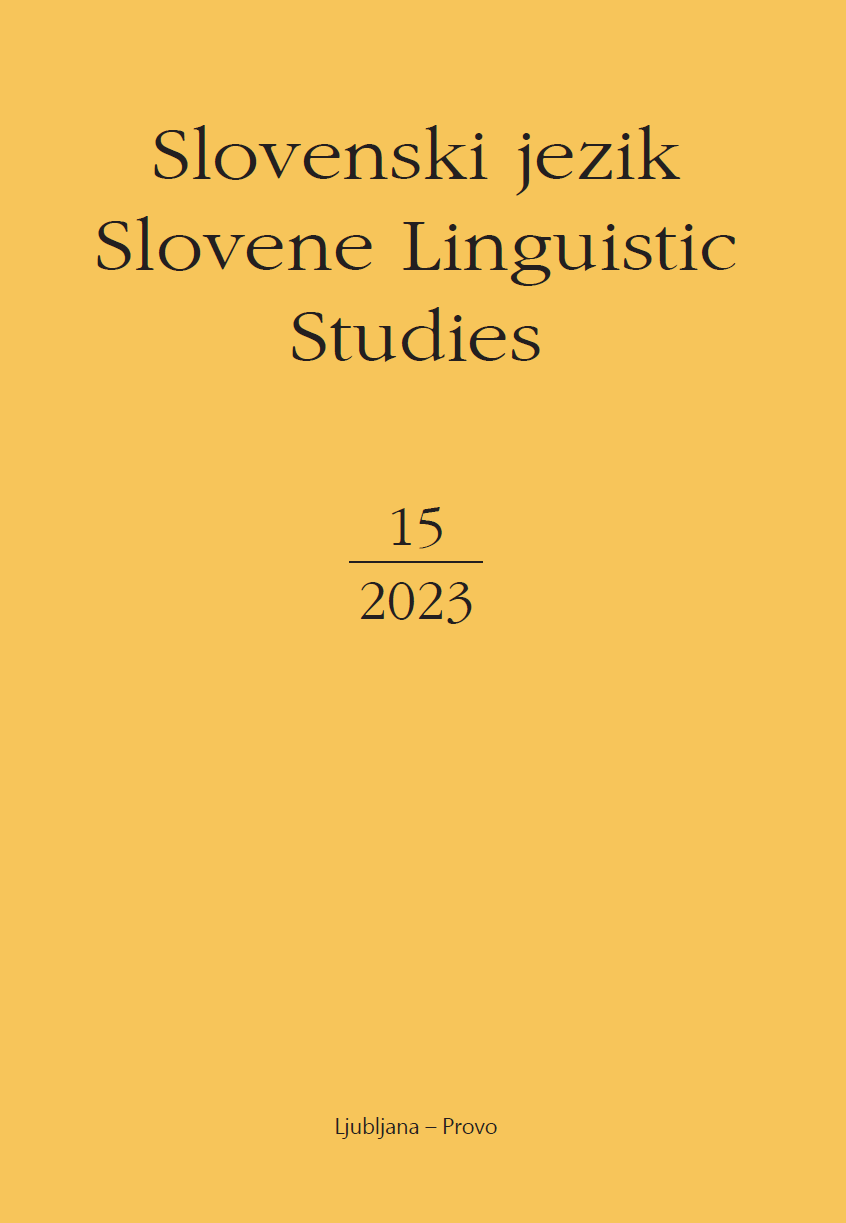Non-Institutional and Grassroots Prescriptivism for Slovenian
DOI:
https://doi.org/10.3986/15.1.07Keywords:
prescriptivism, Slovene, usage guide, grassroots prescriptivism, non-institutional prescriptivismAbstract
The current SP 2001 with supplementary infrastructure (Fran portal, Jezikovna Svetovalnica) has the highest normative authority for the Slovenian speech community. Still, non-institutional usage guides have been appearing in Slovenia, addressing the issues of complicated rules and protracted searches. Since they do help speakers of Slovene resolve some usage problems, two forms of prescriptivism for Slovenian were surveyed: non-institutional prescriptivism and grassroots prescriptivism. Non-institutional prescriptivism is an anglophone invention appearing mostly in book form and is typically based on an author’s sense of style. Grassroots prescriptivism is a relatively novel phenomenon which consists of internet users interacting to solve one another’s usage problems without necessarily being language professionals. For Slovene, it was discovered that several books were published that resemble usage guides. Three have been researched and it was discovered that Pravipis by Aleksandra Kocmut most closely resembles a prototypical usage guide. Interestingly, the authors all cede normative authority to SP 2001, an institutional guide. Most of grassroots prescriptivism is carried out in specific Facebook groups in which their members rapidly respond to posted usage problems. Among other things, it was discovered that grassroots prescriptivism responds to usage problems more quickly while institutional guidace does so in a more reliable and informed manner.
Downloads
References
Ayres-Bennett, Wendy. 2021. Modelling Language Standardization. In: W. Ayres-Bennett, J. Bellamy (eds.). The Cambridge Handbook of Language Standardization. Cambridge: Cambridge University Press. 27–64. DOI: https://doi.org/10.1017/9781108559249.002
Battistella, Edwin L. 2005. Bad Grammar. In: E. L. Battistella (ed.). Bad Language: Are Some Words Better Than Others? New York: Oxford University Press. 41–66. DOI: https://doi.org/10.1093/acprof:oso/9780195172485.003.0004
Tieken-Boon van Ostade, Ingrid. 2011–. Bridging the Unbridgeable. Scholarly Project. Online: https://bridgingtheunbridgeable.com (8. 3. 2023).
Belling, Luc, de Bres, Julia. 2014. Digital Superdiversity in Luxemburg: The role of Luxembourgish in a multilingual Facebook group. Discourse, Context and Media, 4–5/3. 74–86. DOI: https://doi.org/10.1016/j.dcm.2014.03.002
Cameron, Deborah. 1995. Verbal Hygiene. London: Routledge.
Cedilnik, Danica. 1995. Cikcak po pravopisu: za boljšo slovenščino na delovnem mestu. Žalec: Sledi.
Curzan, Anne. 2014. Fixing English: Prescriptivism and Language History. Cambridge: Cambridge University Press. DOI: https://doi.org/10.1017/CBO9781139107327
Dobrovoljc, Helena. 2018. Normativni opis in jezikovna standardizacija v aktualnem jezikovnopolitičnem okviru – dokumenti in realnost. Slavia Centralis, 11/2. 200–223.
Dobrovoljc, Helena, Bizjak Končar, Aleksandra. 2013. Slovenski pravopisi in vprašanje normativnih pristojnosti. Slovenski jezik – Slovene linguistic studies 9, 111–126. Online: https://www.dlib.si/details/URN:NBN:SI:doc-TNGGTKYD.
Dobrovoljc, Helena, Lengar Verovnik, Tina, Vranjek Ošlak, Urška, Michelizza, Mija, Weiss, Peter, Gliha Komac, Nataša. 2020. Kje pa vas jezik žuli? Prva pomoč iz jezikovne svetovalnice. Ljubljana: Založba ZRC.
Gantar, Polona, Krek, Simon. 2009. Drugačen pogled na slovarske definicije: opisati, pojasniti, razložiti? In: M. Stabej (ed.). Infrastruktura slovenščine in slovenistike. Simpozij Obdobja 28. Ljubljana: Znanstvena založba FF. 151–159.
Garvin, Paul L. 1993. A Conceptual Framework for the Study of Language Standardization. International Journal of the Sociology of Language 100–101: 37–54. DOI: https://doi.org/10.1515/ijsl.1993.100-101.37
Haugen, Einar. 1972 [1966]. Dialect, Language, Nation. In: The Ecology of Language: Essays by Einar Haugen. Stanford: Stanford University Press. 235–254
Hávranek, Bohuslav. 1983 [1932]. Emploi et culture de la langue standard. In: É. Bédard, J. Maurais (eds.). La Norme Linguistique. Québec: Gouvernement du Québec. 815–833.
Jaffe, Alexandra. 2021. Polynomic Standards: The Enactment of Legitimate Variation. In: W. Ayres-Bennett, J. Bellamy (eds.). The Cambridge Handbook of Language Standardization. Cambridge: Cambridge University Press. 442–470. DOI: https://doi.org/10.1017/9781108559249
Joseph, John Earl. 1987. Eloquence and Power: The Rise of Language Standards and Standard Languages. London: Frances Pinter.
Kapović, Mate. 2022. O standardnom dijalektu, nacionalizmu i ideologiji. Jezikoslovlje, 23/1. 87–128. Online: https://hrcak.srce.hr/280773.
Kocmut, Aleksandra. 22013. Pravipis: zbirka pogostih pravopisnih kavljev z nekaj napotki za brskanje po e-slovarjih. Ljubljana: Modrijan.
Lengar Verovnik, Tina. 2018. Vejica v pravopisu. Jezik in slovstvo, 63/2–3. 87–101.
Lukač, Morana. 2018. Grassroots Prescriptivism: An Analysis of Individual Speakers’ Efforts at Maintaining the Standard Language Ideology. English Today, 34/4. 5–12. DOI: https://doi.org/10.1017/S0266078418000342
Milroy, James, Milroy, Lesley. 2005 [1985]. Authority in Language: Investigating standard English. London: Routledge.
Nevalainen, Terttu. 2003. English. In: A. Deumert, W.Vandenbussche (eds.). Germanic Standardizations: Past and present. Amsterdam: John Benjamins. 127–156. DOI: https://doi.org/10.1075/impact.18
Orožen, Martina. 1996. Oblikovanje enotnega slovenskega knjižnega jezika v 19. stoletju. Ljubljana: Filozofska fakulteta.
Pertot, Nada. 1997. Pomagajmo si sami. Gorica: Goriška Mohorjeva družba.
Pillière, Linda, Andrieu, Wilfrid, Kerfelec, Valérie, Lewis, Diana. 2018. Norms and Margins of English. In: L. Pillière, W. Andrieu, V. Kerfelec, D. Lewis (eds.). Standardising English: Norms and Margins in the History of the English Language. Cambridge: Cambridge University Press. 3–21. DOI:10.1017/9781108120470.001
Slovenski pravopis. 2007 [2001]. Ljubljana: Založba ZRC.
Starčević, Anđel, Sarić, Daliborka, Kapović, Mate. 2019. Jeziku je svejedno. Suvremena lingvistika, 45/88. 279–284. DOI: https://doi.org/10.22210/suvlin.2019.088.09
Straaijer, Robin. 2018. The Usage Guide: Evolution of a Genre. In: I. Tieken-Boon van Ostade (ed.). English Usage Guides: History, Advice, Attitudes. Oxford: Oxford University Press. 11–29. DOI: https://doi.org/10.1093/oso/9780198808206.001.0001
Toporišič, Jože. 42004. Slovenska slovnica. Maribor: Obzorja.
Tieken-Boon van Ostade, Ingrid. 2011. The Bishop's Grammar: Robert Lowth and the rise of prescriptivism. Oxford: Oxford University Press.
Tieken-Boon van Ostade, Ingrid. 2020. Describing Prescriptivism: Usage Guides and Usage Problems in British and American English. London: Routledge.
Verovnik, Tina. 2004. Norma knjižne slovenščine med kodifikacijo in jezikovno rabo v obdobju 1950–2001. Družboslovne razprave, 20/46–47. 241–258. Online: http://www.dlib.si/?URN=URN:NBN:SI:DOC-2WHL160B.
Žaucer, Rok and Franc Marušič. 2009. Jezikovno svetovanje, praksa in ideali. In: M. Stabej (ed.). Infrastruktura slovenščine in slovenistike. Simpozij Obdobja 28. Ljubljana: Znanstvena založba FF. 449–456.
Downloads
Published
How to Cite
Issue
Section
License

This work is licensed under a Creative Commons Attribution-ShareAlike 4.0 International License.
Authors guarantee that the work is their own original creation and does not infringe any statutory or common-law copyright or any proprietary right of any third party. In case of claims by third parties, authors commit their self to defend the interests of the publisher, and shall cover any potential costs.
More in: Submission chapter





